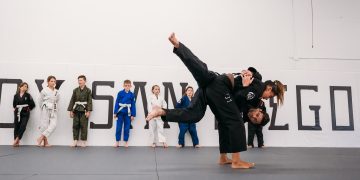
NORTH PARK’S SWITZER CANYON INSPIRED CONSERVATION MOVEMENT
or SEE WHAT STARTED IN SWITZER CANYON
Por Priscilla Lister
Switzer Canyon was the start of something big.
 This open space preserve in North Park once faced the onslaught of a sewer line maintenance road — as did several other canyons in the city. When neighbors were informed about this project, several residents turned to the Sierra Club to help organize a response.
This open space preserve in North Park once faced the onslaught of a sewer line maintenance road — as did several other canyons in the city. When neighbors were informed about this project, several residents turned to the Sierra Club to help organize a response.
In October 1998, the Sierra Club guided about 60 residents on a tour of Switzer Canyon and organized the first canyon “friends” group, which soon became a model for more than 40 canyon friends groups throughout the county.
Ten years later in 2008, with the Sierra Club’s endorsement, San Diego Canyonlands was incorporated as a nonprofit to help preserve and protect San Diego canyons.
Carrie Schneider, current vice president of San Diego Canyonlands’ board, was one of the original participants behind the Switzer Canyon force and remains the leader today of Friends of Switzer Canyon.
“Switzer Canyon is just gorgeous,” said Schneider, a North Park resident with her husband, Bob Laymon. “I think of it as a place where there’s always something interesting going on — every season there’s something new to observe. It’s a great place for hiking.”
“San Diego is known for its beaches and the climate, but the feature that makes us unique among California coastal cities is (the) topography of our canyons,” according to the San Diego Canyonlands Web site: http://sdcanyonlands.org.
“San Diego is an island, botanically speaking,” added Schneider. “It’s surrounded by ocean, mountains and desert, so the vegetation is unique. We find all sorts of amazing plant communities in our canyons.”
Explore Switzer for yourself and see why this island of nature in the middle of the city began such a valuable countywide movement. Its western point begins from Balboa Park’s golf course at 28th Street and Maple Street and goes about four blocks to 30th Street, which bisects it, then begins again at 30th for four more blocks to 32nd Street near Redwood Street. It’s a pretty large swath of a natural canyon in the middle of North Park, and took me a little more than an hour to walk both segments round-trip.
The western trailhead at 28th and Maple begins with the very green views into Balboa Park’s golf course. After a pretty steep decline, you enter Switzer Canyon and follow the trail, much of which appears to be a rocky old dry stream bed.
The Friends of Switzer Canyon have been working hard on canyon restoration, involving the removal of non-native plants and the planting of natives. A couple areas of habitat restoration are evident. “One of the biggest problems natural habitats face is unchecked growth of some plants from other parts of the world,” said Schneider, who is a biologist for Pfenex Inc. in Mira Mesa. “They can become a different place, supporting different animals, making it less biologically diverse.”
The San Diego Natural History Museum has compiled an exhaustive “Floristic List for Switzer Canyon,” citing hundreds of plants and trees that make their home here(www.sdnhm.org/research/botany/list/switzer.html) I caught wind of the lovely fragrance from Black Sage, marveled at the velvet leaves of Yerba Santa, and enjoyed the yellow blooms of the Evening Primrose.
There are several towering eucalyptus trees here, especially in the eastern section between 30th and 32nd, where there are also several specimen Queen Palms. Also in that section are some lovely old pepper trees.
That eastern section is a bit easier to navigate because the trail isn’t so much a rocky stream bed but more like an old dirt road. But be advised the trail doesn’t go between the sections easily. To exit the western section and reach 30th Street, watch for a graffiti-covered old cement drainage tunnel. When you see that, go toward it and up the makeshift trail to 30th.
Walk along 30th to the northern edge of the canyon and find another steep entry trail into that eastern section. The entries/exits off 30th are very steep and not actual trails, but you can make this connection between the two sections of Switzer Canyon. The official entries into the eastern section nearest 30th are at the end of Burlingame off San Marcos Avenue, or at the dead-end of Palm Street toward 31st.
The best map of Switzer Canyon can be downloaded from http://www.sandiego.gov/park-and-recreation/pdf/switzertrailmap.pdf.
You might even hear a coyote if a fire truck rolls down 30th. “They really love the fire trucks — even during they day they’ll start howling,” noted Schneider.
You might also see the nests of dusky-footed woodrats. “They make amazing collections of sticks for their nests. They like to collect shiny objects and build their nests under chaparral trees. Some of these nests are many years old,” she said.
San Diego Canyonlands continues to develop friends groups to help protect these natural oases. The newest group has been formed in City Heights for the 47th Street Canyon.
And Switzer Canyon started it all.












Discussion about this post